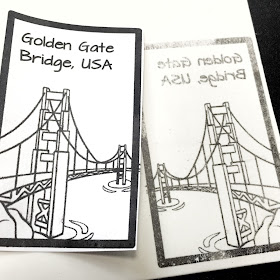 |
| Butter Kut from Stampeaz |
(If you want a particular medium reviewed, feel free to send me an email or put it in the comments below - otherwise, I'll just keep going through the materials as I pull them out of my drawer.)
The price isn't too bad for the size of the sheet, although I'm skewed because of the shipping charges. But heck, I'm a hussy for carving mediums, I'll try anything ;)
My first thought when it arrived was to be taken aback at how thin it is. I'm so used to all of the other white materials that come out of Stampeaz's shop, that it never occurred to me that it would be any different... On to the review!
Appearance:
It's been a reeeeeally long time since I carved on Master Carve by Staedtler (discontinued), but this stuff feels and seems to be a thin slice of what I remember the Master Carve material to be like. The texture is obviously rubbery and almost... Marshmallow-y?
Size and Weight:
 |
| Transfer using acetone |
Transfer:
Sigh. No heat transfer, but acetone works. This is not the first material to act like this and I would love an explanation as to why heat won't work to reattach the pigments to the rubber, but acetone can. Whyyy?
Crumble Factor:
I noticed while I was rubbing the acetone over the paper that the material was pilling where the cotton wiped the rubber. Not wonderful. Later, while inking, I noticed more pilling... no crumbling, but this stuff does pill up.
Carving:
 Okay, so while the big knife I used to cut through the material went fine, the Xacto blade didn't love to cut through the material. Also, what is tricky is that if I mis-sliced, in other words if I sliced too far away from the design, and needed to shave off a little extra, this was extremely difficult. I really had to make sure I sliced right in the first pass.
Okay, so while the big knife I used to cut through the material went fine, the Xacto blade didn't love to cut through the material. Also, what is tricky is that if I mis-sliced, in other words if I sliced too far away from the design, and needed to shave off a little extra, this was extremely difficult. I really had to make sure I sliced right in the first pass.With a knife, it was quite hard to carve straight lines and make perfect corners - which, let's face it, is why you would want to carve with a knife in the first place.
It also dulled my knife very quickly. When dull, it dragged the rubber, leaving a ragged line and would veer the cut off course. The rubbery-ness of the material pull at the knife while slicing, so you have to really concentrate at making sure your cut is true.
While knife carving the text, the material broke out quite easily, which is nice. After a bit of rubbing of the text, I was fairly satisfied that the text wouldn't crumble off.
Gouge carving was a little nicer, and the material seemed to like that better. I think if I had a large piece that I needed to gouge carve, this would be the perfect material.
 |
| Click to enlarge |
Inking:
Pretty good and even. Nothing to complain about here. However, if you click on the image and look carefully, you can see how uneven the lines of the bridge are (although from further away, I suppose it's fine).
Conclusions:
While I like that it's generally soft, I prefer to knife carve these days and there is a pull when trying to slice that I don't like. It's fairly soft though, so I will happily use this slab up.
No comments:
Post a Comment